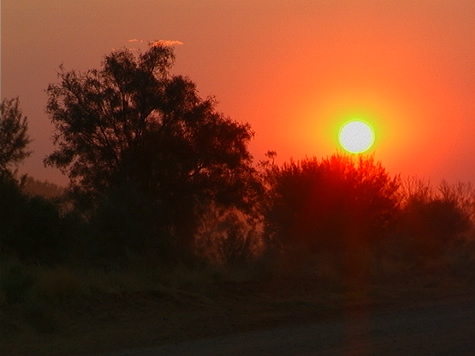Our bodies are a beautiful example of a homeostatic system, that is, a system that keeps itself in balance. One example of this homeostasis is temperature regulation. Most of us have been out in snow or cold temperatures, and have started shivering. By shivering, our muscles contract and relax very quickly, which causes a buildup of heat, thus balancing out heat loss. In contrast, when our bodies overheat (due to a hot day, fever, or exercise), we sweat. When the salty water that appears on our skin evaporates, it helps the body to cool down.

Here in the Tanami Desert, we face daily air temperatures around 100 degrees Fahrenheit (36 degrees Celsius). You can imagine that when we bike under these sweltering conditions, we lose a great deal of fluid in our bodies to sweating. But where does this fluid come from, and what are the consequences of losing it?
The body’s water is stored in three areas: inside cells, between cells, and in the blood. In order to sweat, water is taken from these compartments and drawn out onto the skin, along with various chemical ions (also called electrolytes). One of these ions is sodium, similar to your everday table salt, which is why your sweat tastes salty. A bit of sweating is good for the body and keeps it from overheating. However, your blood and tissues are sacrificing the water and electrolytes out of their own stores, which throws their systems out of balance. Such loss of water, termed dehydration, can lead to thirst, dry mouth, saggy skin, headache, fainting, and several other unpleasant symptoms.
Besides dehydration, another problem we face is overexposure to the sun’s heat. This leads to heat exhaustion (headache, nausea, fatigue, faintness, and a great deal of sweating), the more serious heat stroke (headache, nausea and vomiting, no sweating), and prickly heat (a rash due to the inflammation of sweat glands after long periods of exposure to high temperatures).
In order to avoid all these possible consequences, we drink a lot of water and take salt tablets when we feel weak and overheated. Unfortunately, as the temperatures seem to rise day by day, we’re finding it very difficult to cycle during the hottest parts of the trip (between 11 a.m. and 3 p.m.). For this reason, we will try something new tomorrow: cycling from dawn until 11 a.m., and then again from 4 p.m. until sunset. In between, we’ll sit in whatever shade we can find, drink gallons of water, and write these updates to you!
Git